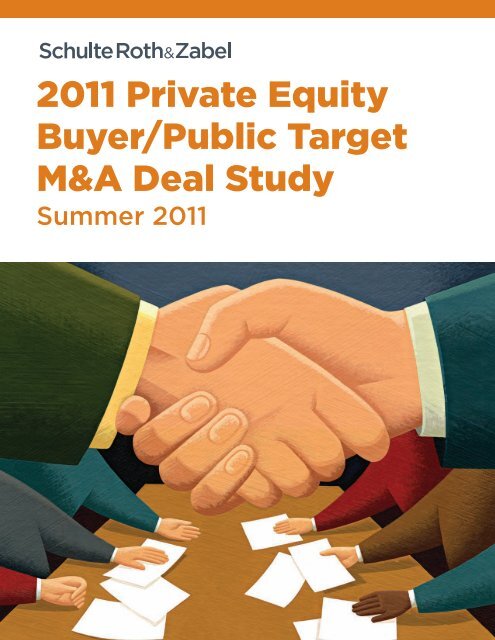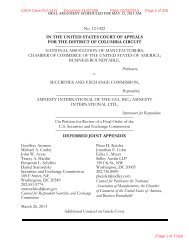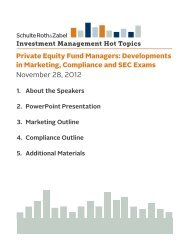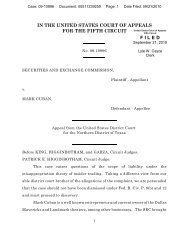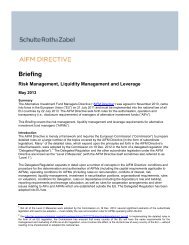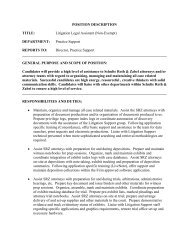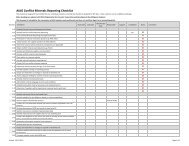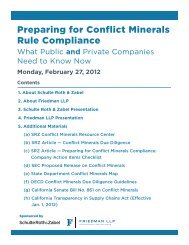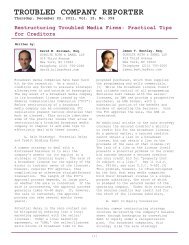2011 Private Equity Buyer/Public Target M&A Deal Study
2011 Private Equity Buyer/Public Target M&A Deal Study
2011 Private Equity Buyer/Public Target M&A Deal Study
You also want an ePaper? Increase the reach of your titles
YUMPU automatically turns print PDFs into web optimized ePapers that Google loves.
<strong>2011</strong> <strong>Private</strong> <strong>Equity</strong><br />
<strong>Buyer</strong>/<strong>Public</strong> <strong>Target</strong><br />
M&A <strong>Deal</strong> <strong>Study</strong><br />
Summer <strong>2011</strong>
<strong>2011</strong> <strong>Private</strong> <strong>Equity</strong> <strong>Buyer</strong>/<strong>Public</strong><br />
<strong>Target</strong> M&A <strong>Deal</strong> <strong>Study</strong><br />
Summer <strong>2011</strong><br />
Table of Contents<br />
Key Observations<br />
Survey Methodology<br />
Page<br />
i<br />
iii<br />
Surveyed Transaction Terms<br />
<strong>Deal</strong> Structure 1<br />
One-Step Merger vs. Two-Step Tender Offer/Back-End Merger 1<br />
<strong>Target</strong> Fiduciary Duty Issues 3<br />
Go-Shop Provisions 3<br />
Change in <strong>Target</strong> Board Recommendation 4<br />
<strong>Deal</strong> Protections for <strong>Buyer</strong> 5<br />
Match and “Last Look” Rights 5<br />
“Force the Vote” Provision 7<br />
Break-Up Fee Payable by the <strong>Target</strong> 8<br />
Expense Reimbursement by the <strong>Target</strong> 9<br />
<strong>Target</strong>’s Obligation to Pay a Termination Fee During a “Tail” Period 11<br />
<strong>Deal</strong> Certainty Provisions for the <strong>Target</strong> 12<br />
<strong>Target</strong>’s Ability to Obtain Specific Performance Against the <strong>Buyer</strong> 12<br />
Reverse Termination Fees 13<br />
Select <strong>Buyer</strong> Closing Conditions 15<br />
Marketing Periods 16<br />
Other Selected <strong>Deal</strong> Points 18<br />
Appendices<br />
Appendix A — Surveyed Transactions 19<br />
Appendix B — Additional Charts and Graphs 20<br />
Appendix C — Break-Up Fees and Reverse Termination Fees 21
Key Observations<br />
We conducted our survey, in part, to observe any notable trends or themes based on our<br />
review of the 25 transactions. Please note, however, that in our experience, particularly<br />
in terms of deal-making post-2008 credit crisis, these deals are often sui generis due to<br />
a number of factors, including the marketability/prospects of the target, the regulatory<br />
profile of the transaction, whether the agreement is the product of dedicated one-on-one<br />
negotiations, a formal auction or somewhere in between, the state of credit markets and the<br />
recent historical track record of the buyer. Accordingly, undue weight should not be placed<br />
on this study — it is intended to help identify “market practice” for individual deal terms and<br />
assist on negotiations, but does not purport to establish what is appropriate for any given<br />
transaction.<br />
Our key observations are as follows:<br />
• As expected, we observed a “market practice” based on the treatment/inclusion of a<br />
number of the key deal terms. For example:<br />
o None of the deals included a traditional “force the vote” provision or provided<br />
the buyer with a closing condition regarding appraisal rights.<br />
o None of the deals structured as single-step mergers provided the buyer with a<br />
financing closing condition.<br />
o Approximately 90% of the deals:<br />
• Permitted the target board to make a change in recommendation other<br />
than specifically in connection with a superior proposal;<br />
• Provided the buyer with matching rights and “last look” matching rights;<br />
• Included a “tail provision” that applied in the event the merger<br />
agreement was terminated under certain circumstances; and<br />
• Had “marketing period” provisions.<br />
o 80% of the deals were structured as one-step mergers.<br />
o Approximately 75% of the deals gave the target company a limited specific<br />
performance right that was only available if (i) the buyer’s closing conditions<br />
to the merger agreement were satisfied and (ii) the buyer’s debt financing was<br />
available.<br />
• The size of the break-up fee payable by the target company (as a percentage of<br />
target’s equity value) did not decrease significantly as the size of the deal tripled<br />
or quadrupled. We had expected to find that as the size of the deal increased, the<br />
break-up fee (as a percentage of equity value) payable by the target company would<br />
decrease significantly.<br />
• The range of the reverse termination fee (“RTF”) payable by a buyer (as a percentage<br />
of target’s equity value) varied dramatically. We had expected to find a tighter range<br />
in the RTFs payable by buyers — instead the range varied dramatically in certain<br />
instances (e.g., 5.51% to 38% in the event of a willful breach (the highest was the GTCR/<br />
Protection One deal)).<br />
<strong>2011</strong> <strong>Private</strong> <strong>Equity</strong> <strong>Buyer</strong>/<strong>Public</strong> <strong>Target</strong> M&A <strong>Deal</strong> <strong>Study</strong> | Summer © <strong>2011</strong> Schulte Roth & Zabel LLP. All rights reserved. | i
• While “go-shop” provisions are not “market practice,” they are widely used and<br />
not exceptions to the rule. Of the 25 deals, approximately 50% included a “go-shop”<br />
provision.<br />
• While there have recently been innovations in deal terms in strategic acquisitions of<br />
U.S. public companies, these innovations have not spread to transactions involving<br />
private equity buyers. In general, the deal terms we reviewed were either customary<br />
or variations of customary provisions. Other than the dual-track one-step merger/<br />
two-step tender/offer back-end merger approach used in 3G Capital/Burger King<br />
and Apax/Epicor (described on page 1), we did not see any terms that, in our view,<br />
represented a significant departure from market practice. For example, a hybrid of the<br />
“go-shop” and ”no-shop” provisions was used in a few recent transactions involving<br />
non-financial buyers (e.g., Nicor/AGL Resources and AES Corp./DPL Inc.), however,<br />
such a provision was not included in any of the 25 deals we reviewed. Similarly, a fallaway<br />
provision to the “last look” matching right (discussed on page 5) was included<br />
in Leonard Green & Partners/Prospect Medical, but not in any of the 25 deals we<br />
reviewed, excluding the amended merger agreement in the TPG/J.Crew transaction<br />
(which is disregarded for purposes of our survey because of the potential impact the<br />
related deal litigation may have had on one or more deal terms).<br />
<strong>2011</strong> <strong>Private</strong> <strong>Equity</strong> <strong>Buyer</strong>/<strong>Public</strong> <strong>Target</strong> M&A <strong>Deal</strong> <strong>Study</strong> | Summer © <strong>2011</strong> Schulte Roth & Zabel LLP. All rights reserved. | ii
Survey Methodology<br />
This study analyzes the terms of financial buyer acquisitions of public company targets. We<br />
reviewed the 25 cash merger agreements entered into between U.S. public companies and<br />
financial buyers for consideration of at least $500 million in enterprise value 1 during the period<br />
from Jan. 1, 2010 to June 1, <strong>2011</strong>. Our findings described in this survey are not intended to be<br />
an exhaustive review of all transaction terms in the surveyed transactions; instead, we report<br />
only on those matters that we found most interesting.<br />
Our observations are based on a review of publicly available information for the surveyed<br />
transactions. The surveyed transactions accounted for only a portion of M&A activity during<br />
the survey period and may not be representative of the broader M&A market.<br />
A summary of the surveyed transactions is attached as Appendix A.<br />
1<br />
The equity values of the 25 transactions ranged from $331 million to $3.8 billion (calculated based on outstanding<br />
stock, excluding options, warrants and other securities convertible into or exercisable for common stock).<br />
<strong>2011</strong> <strong>Private</strong> <strong>Equity</strong> <strong>Buyer</strong>/<strong>Public</strong> <strong>Target</strong> M&A <strong>Deal</strong> <strong>Study</strong> | Summer © <strong>2011</strong> Schulte Roth & Zabel LLP. All rights reserved. | iii
<strong>Deal</strong> Structure<br />
We reviewed the 25 transactions to determine whether they were structured as one-step<br />
statutory mergers or two-step tender offer/back-end mergers.<br />
1. One-Step Merger vs. Two-Step Tender Offer/Back-End Merger<br />
Of the 25 transactions:<br />
• 20 of the 25 transactions (80%) were one-step mergers; the remaining 5 transactions<br />
(20%) were two-step tender offer/back-end mergers.<br />
• 2 of the 5 two-step tender offer/back-end mergers (8% overall) — 3G Capital/Burger<br />
King and Apax/Epicor — employed a dual-track structure of pursuing a merger and<br />
tender offer at the same time, so that whichever method resulted in faster approval of<br />
the transaction could be used to complete the transaction. In both 3G Capital/Burger<br />
King and Apax/Epicor, the tender offer was used to complete the transaction.<br />
o A dual-track structure requires both the buyer to launch a tender offer<br />
promptly after signing and the target to file a preliminary proxy statement<br />
promptly after signing (while the tender offer is pending), and, to the extent<br />
the target stockholder meeting is necessary for the buyer to consummate<br />
a back-end merger, for the target to hold its stockholder meeting to obtain<br />
stockholder approval. The dual-track structure is useful where the target does<br />
not have enough authorized but unissued shares (plus shares held in treasury)<br />
to grant the buyer a top-up option sufficient to obtain the shares required for<br />
a short form merger based on 50.01% of the target stockholders tendering into<br />
the offer.<br />
• The other 3 two-step merger agreements only required the target to file a proxy<br />
statement and hold a meeting to obtain stockholder approval if required by law, i.e., if<br />
the tender offer, together with the exercise of the top-up option, was not sufficient to<br />
obtain the 90% required to complete a short form merger.<br />
In general, the benefit of a tender offer is the ability — in deals involving no regulatory issues — to<br />
close in as little as 1 to 2 months as compared to a traditional one-step merger, which usually<br />
takes 2 to 3 months to close. 2 Historically, private equity buyers have been reluctant to use<br />
the two-step structure because of, among other things, the margin rules limiting borrowing<br />
to 50% of the value of the collateral pledged to secure the loan made it difficult to obtain<br />
acquisition financing to fund the tender offer. Several developments have made tender offers<br />
more attractive:<br />
o In 2006, the SEC clarified that the “all holders/best price rule” does not<br />
apply to employment compensation, severance or other employee benefit<br />
arrangements that meet certain criteria, which provided comfort to private<br />
equity buyers concerned about the treatment of target management postclosing<br />
arrangements.<br />
o The use of the top-up option, which allows the buyer to ensure that it will<br />
reach the ownership threshold needed to complete a short form merger, allows<br />
private equity buyers to structure financing in a way that navigates the margin<br />
rules.<br />
2<br />
Timing assumes the SEC staff does not issue any comments.<br />
<strong>2011</strong> <strong>Private</strong> <strong>Equity</strong> <strong>Buyer</strong>/<strong>Public</strong> <strong>Target</strong> M&A <strong>Deal</strong> <strong>Study</strong> | Summer © <strong>2011</strong> Schulte Roth & Zabel LLP. All rights reserved. | 1
o Recent Delaware decisions 3 have provided guidance on properly structuring a<br />
top-up option to withstand stockholder litigation.<br />
o Tender offers also offer an advantage in dealing with stockholder opposition to<br />
a transaction.<br />
While delay of a stockholder meeting to solicit additional votes in the face of opposition is<br />
possible, it is more vulnerable to court challenge. In contrast, a tender offer can easily be<br />
extended repeatedly until the minimum tender offer condition is satisfied.<br />
Going forward, we would expect to see private equity buyers use the two-step structure more —<br />
at least in transactions that do not involve significant regulatory or antitrust issues — to take<br />
advantage of the tender offer’s timing benefit.<br />
3<br />
See Joanne Olson v. ev3, Inc., C.A. No. 5583 (Del. Ch. Feb. 21, <strong>2011</strong>) and In re Cogent, Inc. Shareholder Litigation,<br />
Cons. C.A. No. 5780 (Del. Ch. Oct. 5, 2010).<br />
<strong>2011</strong> <strong>Private</strong> <strong>Equity</strong> <strong>Buyer</strong>/<strong>Public</strong> <strong>Target</strong> M&A <strong>Deal</strong> <strong>Study</strong> | Summer © <strong>2011</strong> Schulte Roth & Zabel LLP. All rights reserved. | 2
<strong>Target</strong> Fiduciary Duty Issues<br />
We reviewed the 25 transactions for certain provisions related to the target board’s satisfaction<br />
of its fiduciary duties.<br />
2. Go-Shop Provisions<br />
We reviewed the 25 transactions to determine which of them included a “go-shop” provision<br />
(i.e., a provision that grants the target the affirmative right — during a specified period of time —<br />
to solicit alternate acquisition proposals). As noted in the following chart:<br />
• 14 of the 25 transactions (56%) had “go-shop” provisions.<br />
• The “go-shop” periods ranged from 21 to 54 days (median: 40 days; mean 37.6 days). 4<br />
• Of the 14 transactions with “go-shop” provisions, 7 of them had language that permitted<br />
the target board to continue negotiations with an “excluded party” (generally defined<br />
as any party that made a written acquisition proposal during the go-shop period)<br />
without the need for the target board to determine whether the excluded party’s offer<br />
constituted, or was reasonably likely to constitute, a superior proposal.<br />
o Of these 7 transactions, 2 limited the period during which negotiations with<br />
excluded parties are permitted to 15 days after the “no-shop” start date, 1<br />
transaction limited the period to 20 days after the “no-shop” start date, and 4<br />
transactions had no such restrictions.<br />
Recently, a handful of transactions involving strategic buyers and public company targets have<br />
included a hybrid “go-shop/no-shop” provision that does not provide the target with a “goshop”<br />
right but specifies that a lower termination fee applies in the event the target accepts a<br />
superior proposal during a limited period of time after the execution of the merger agreement.<br />
We have yet to see such a provision in public company transactions involving private equity<br />
buyers, but there is no reason why it could not be used.<br />
Length of Go-Shop Periods<br />
60<br />
Length of Go-Shop Period in Days<br />
50<br />
40<br />
30<br />
20<br />
10<br />
0<br />
RCN<br />
Mean = 37.6 days<br />
infoGroup<br />
BWAY<br />
DynCorp<br />
NBTY<br />
Burger King<br />
Gymboree<br />
Am. Com. Lin.<br />
CommScope<br />
J. Crew<br />
Del Monte<br />
Jo-Ann<br />
SRA<br />
Epicor<br />
4<br />
For purposes of computing the range, median and mean, we omitted the extension of the go-shop period from 53 to<br />
85 days in the amended J. Crew/TPG merger agreement.<br />
<strong>2011</strong> <strong>Private</strong> <strong>Equity</strong> <strong>Buyer</strong>/<strong>Public</strong> <strong>Target</strong> M&A <strong>Deal</strong> <strong>Study</strong> | Summer © <strong>2011</strong> Schulte Roth & Zabel LLP. All rights reserved. | 3
3. Change in <strong>Target</strong> Board Recommendation<br />
As expected, all of the transactions we surveyed permitted the target’s board of directors to<br />
change its recommendation (“CIR”) to its stockholders to approve the merger under certain<br />
circumstances in order to satisfy fiduciary duty requirements. 5 However, buyers continue to be<br />
able to limit the scope of that right in various ways. As noted in the following chart:<br />
• In 3 of the 25 transactions (12%), the target board was permitted to make a CIR only in<br />
connection with a superior proposal.<br />
• The remaining 22 transactions (88%) permitted the target board to make a CIR other<br />
than specifically in connection with a superior proposal. Of these 22 transactions:<br />
o 12 transactions (48% overall) permitted the target board to make a CIR based<br />
on the Board’s determination that its fiduciary duties required a CIR — without<br />
specific language in the agreement as to the underlying reasons for such CIR.<br />
o 10 transactions (40% overall) had more restrictive language — permitting the<br />
target board to make a CIR only in connection with an “intervening event”<br />
(generally defined as an event or circumstance that the target board becomes<br />
aware of after signing the merger agreement that results in the target board<br />
determining that its failure to make a CIR would be inconsistent with its<br />
fiduciary duties) but not generally to satisfy its fiduciary duties.<br />
Change in Recommendation (CIR) Triggers<br />
CIR Permitted Absent<br />
a Superior Proposal<br />
88%<br />
Intervening Event<br />
Required: 40% Overall<br />
CIR Only in<br />
Connection<br />
With a<br />
Superior<br />
Proposal<br />
12%<br />
General Fiduciary<br />
Out: 48% Overall<br />
Our survey results were consistent with recent views of Delaware legal experts that a fiduciary<br />
out for general purposes or an intervening event is necessary.<br />
5<br />
We also reviewed the 25 transactions to analyze the various formulations of the standard that applies when<br />
determining when a target board is permitted to make a CIR:<br />
• 13 of the 25 transactions (52%) used “would be inconsistent with” or “would likely be inconsistent with” its<br />
fiduciary duties.<br />
• 5 of the 25 transactions (20%) used “would be reasonably likely to be inconsistent with” its fiduciary duties.<br />
• 4 of the 25 transactions (16%) used “could be inconsistent with” its fiduciary duties.<br />
• 3 of the 25 transactions (12%) used “would be reasonably likely to violate” its fiduciary duties.<br />
<strong>2011</strong> <strong>Private</strong> <strong>Equity</strong> <strong>Buyer</strong>/<strong>Public</strong> <strong>Target</strong> M&A <strong>Deal</strong> <strong>Study</strong> | Summer © <strong>2011</strong> Schulte Roth & Zabel LLP. All rights reserved. | 4
<strong>Deal</strong> Protections for <strong>Buyer</strong><br />
We reviewed the 25 transactions for provisions designed to protect the buyer’s deal against<br />
topping bids and target stockholder opposition.<br />
4. Match & “Last Look” Match Rights<br />
We reviewed the 25 transactions to determine whether the buyer had initial “matching” and<br />
“last look” matching rights under the merger agreement. Initial matching rights provide the<br />
buyer with an opportunity to negotiate with the target board during a specific period of time<br />
after receipt of notice from the target board of an intended CIR and propose modified terms<br />
that are sufficiently improved so as to preclude the target from effecting a CIR. “Last look”<br />
matching rights provide the buyer with a further right to negotiate in the event that the other<br />
bidder revises its proposed terms.<br />
• All of the transactions had initial matching rights and almost all (24 of 25; 96%) had<br />
“last look” matching rights.<br />
• As noted in the following charts:<br />
o The range of initial matching rights was 3 to 7 days (mean: 4.4 days; median<br />
4 days); and<br />
o The range of “last look” matching rights was 1 to 5.6 days (mean: 3.1 days;<br />
median 4 days).<br />
We note that in In re Smurfit-Stone Container Corp. Shareholder Litigation, C.A. No. 6164 (Del.<br />
Ch. May 20, <strong>2011</strong>), Vice Chancellor Parsons of the Delaware Chancery Court determined that<br />
each of the deal protection provisions agreed to by the target, which included, among other<br />
protections, a three-day “matching right” provision, were “standard,” whether considered<br />
alone or as a group. 6<br />
We also reviewed the 24 transactions with initial matching and “last look” matching rights to<br />
compare the durations for the initial matching and “last look” matching rights. As noted in<br />
Chart B-1 in Appendix B:<br />
• In 9 of the 24 transactions (38%), the durations were identical.<br />
• In 4 of the 24 transactions (17%), the duration for the “last look” matching right was<br />
approximately 50% of the initial matching right duration.<br />
A part of the settlement of the shareholders litigation over the J.Crew/TPG merger, TPG<br />
agreed to an elimination of its matching rights in the event a competing bidder outbid TPG by<br />
$2.00 per share or more (a 4.5% premium to the TPG price). We also note that in at least one<br />
recent transaction not included in our study (Leonard Green & Partners/Prospect Medical),<br />
the buyer’s contractual matching rights were eliminated if a competing bidder outbid the<br />
buyer’s price by more than 10%.<br />
6<br />
The other deal protection provisions included a “no-shop” clause and a break-up fee of approximately 3.4% of the<br />
equity value.<br />
<strong>2011</strong> <strong>Private</strong> <strong>Equity</strong> <strong>Buyer</strong>/<strong>Public</strong> <strong>Target</strong> M&A <strong>Deal</strong> <strong>Study</strong> | Summer © <strong>2011</strong> Schulte Roth & Zabel LLP. All rights reserved. | 5
Length of Match & “Last Look” Match Rights<br />
30<br />
50<br />
25<br />
40<br />
20<br />
% of <strong>Deal</strong>s<br />
30<br />
20<br />
% of <strong>Deal</strong>s<br />
15<br />
10<br />
10<br />
5<br />
0<br />
3 4 5 6<br />
7<br />
0<br />
0 1<br />
Calendar Days of Match Right<br />
Calendar Days<br />
30<br />
25<br />
20<br />
% of <strong>Deal</strong>s<br />
15<br />
10<br />
5<br />
7<br />
0<br />
0 1 2 3<br />
4 5<br />
t<br />
Calendar Days of “Last Look” Match Right<br />
<strong>2011</strong> <strong>Private</strong> <strong>Equity</strong> <strong>Buyer</strong>/<strong>Public</strong> <strong>Target</strong> M&A <strong>Deal</strong> <strong>Study</strong> | Summer © <strong>2011</strong> Schulte Roth & Zabel LLP. All rights reserved. | 6
5. “Force the Vote” Provision<br />
None of the 25 transactions we reviewed included a traditional unqualified “force the vote”<br />
(“FTV”) provision (i.e., a clause that requires the target board to submit the proposed<br />
transaction to a vote of target stockholders, even if the target’s board has made a CIR prior to<br />
termination of the agreement). This is a pro-buyer provision because it can discourage other<br />
bidders from making a topping bid given that the target cannot terminate the agreement to<br />
accept final bids. By requiring a stockholder vote, an FTV provision necessitates the drawnout<br />
process of filing the proxy statement and securing applicable consents and regulatory<br />
approvals before the target can enter a transaction with another bidder.<br />
Note that 11 of the 25 transactions (44%) contained a limited FTV provision that requires the<br />
target to hold the stockholder vote on the transaction despite a CIR unless the agreement<br />
is terminated. A limited FTV provision offers little protection when the target is terminating<br />
the agreement to enter into an agreement for a superior proposal, but may offer some<br />
protection in the context of a CIR for an intervening event that does not otherwise give rise to<br />
a termination right.<br />
<strong>2011</strong> <strong>Private</strong> <strong>Equity</strong> <strong>Buyer</strong>/<strong>Public</strong> <strong>Target</strong> M&A <strong>Deal</strong> <strong>Study</strong> | Summer © <strong>2011</strong> Schulte Roth & Zabel LLP. All rights reserved. | 7
6. Break-Up Fee Payable by the <strong>Target</strong><br />
We reviewed the 25 transactions to calculate the size of the target’s “break-up fee” (as a<br />
percentage of equity value) in the event the target chose to terminate the merger agreement<br />
to accept a superior proposal. As noted in the following chart:<br />
• The range of break-up fees (as a percentage of equity value) was 0.72% to 4.99%<br />
(mean: 3.15%; median: 3.12%).<br />
% <strong>Equity</strong> Values<br />
6%<br />
5%<br />
4%<br />
3%<br />
2%<br />
1%<br />
0%<br />
Break-Up Fees<br />
Mean = 3.15%<br />
RCN<br />
infoGroup<br />
BWAY<br />
DynCorp<br />
CKE<br />
Protect. One<br />
Inter. Data<br />
inVentiv<br />
SonicWall<br />
NBTY<br />
Burger King<br />
Int. Brands<br />
Gymboree<br />
Am. Comm. Lin.<br />
CommScope<br />
Syniverse<br />
J. Crew<br />
CPI<br />
Del Monte<br />
Jo-Ann<br />
Pre-Paid<br />
EMSC<br />
SRA<br />
Epicor<br />
CKx<br />
As with other deal protection devices, Delaware courts have not provided any bright-line<br />
rules regarding when a break-up fee will be deemed unreasonable in amount. Nevertheless,<br />
practitioners can take comfort that fees in the range of 2.0% to 4.0% of equity value are<br />
generally permissible.<br />
Delaware jurisprudence, most recently in the In re Cogent Inc. Shareholder Litigation, suggests<br />
that equity value may be the appropriate metric for calculating a break-up fee where a target<br />
has minimal debt. Conversely, where the buyer is assuming a significant amount of a target’s<br />
debt, enterprise value may be the appropriate metric.<br />
Given a wide range of fees and deal size, we grouped the 25 transactions by deal size and<br />
noted the range of break-up fees (as a percentage of deal size 7 ). Somewhat surprisingly, we<br />
observed that the average size of the break-up fee as a percentage of equity value did not<br />
decrease appreciably as the deal size increased:<br />
<strong>Deal</strong> Size<br />
(<strong>Equity</strong> Value)<br />
Up to $1 Billion<br />
(13 of 25 Transactions)<br />
$1 Billion to $3 Billion<br />
(7 of 25 Transactions)<br />
$3 Billion to $4 Billion<br />
(5 of 25 Transactions)<br />
Range Mean Median<br />
2.02% to 4.99% 3.40% 3.30%<br />
0.72% to 4.11% 2.68% 2.79%<br />
2.82% to 3.70% 3.19% 3.14%<br />
7<br />
All break-up fees were structured so as to be paid net of any reimbursements for expenses.<br />
<strong>2011</strong> <strong>Private</strong> <strong>Equity</strong> <strong>Buyer</strong>/<strong>Public</strong> <strong>Target</strong> M&A <strong>Deal</strong> <strong>Study</strong> | Summer © <strong>2011</strong> Schulte Roth & Zabel LLP. All rights reserved. | 8
7. Expense Reimbursement by the <strong>Target</strong><br />
We reviewed the 25 transactions to determine which of them required the target to reimburse<br />
the buyer for transaction expenses and the size of and triggers for such reimbursement<br />
obligation.<br />
• 17 of the 25 transactions (68%) imposed an expense reimbursement obligation on<br />
the target. 8 As noted in the following chart, the triggers for this obligation were<br />
termination of the agreement due to:<br />
o <strong>Target</strong>’s shareholders rejecting the proposed merger: 17 of the 17 transactions<br />
(100%), of which:<br />
• 14 (82% of this subset) did not require the existence of a competing<br />
acquisition proposal prior to termination (i.e., a “naked no-vote”).<br />
• 2 (12% of this subset) required that the target board had made a CIR<br />
prior to termination. 9<br />
• 1 (6% of this subset) required that an alternative acquisition proposal<br />
had been made and not been withdrawn prior to termination.<br />
o <strong>Target</strong>’s material breach of representations or covenants: 10 of the 17<br />
transactions (59%).<br />
o <strong>Target</strong>’s entry into an alternative acquisition proposal: 5 of the 17 transactions<br />
(29%).<br />
o Change of target board’s recommendation: 5 of the 17 transactions (29%).<br />
o Material adverse effect on target: 1 of the 17 transactions (6%).<br />
o Failure of the parties to consummate the closing by the outside date: 1 of the 17<br />
transactions (6%).<br />
8<br />
In addition, the TPG/J. Crew merger agreement was amended to provide expense reimbursement if a third-party<br />
bidder made a superior proposal and was subsequently outbid.<br />
9<br />
Two transactions (CPI and inVentiv) allow for expense reimbursement where there is a “naked no-vote” but only in<br />
the situation where the target board has changed its recommendation. Both transactions also provided for payment<br />
of a termination fee if the board had changed its recommendation.<br />
<strong>2011</strong> <strong>Private</strong> <strong>Equity</strong> <strong>Buyer</strong>/<strong>Public</strong> <strong>Target</strong> M&A <strong>Deal</strong> <strong>Study</strong> | Summer © <strong>2011</strong> Schulte Roth & Zabel LLP. All rights reserved. | 9
<strong>Target</strong> Expense Obligation Triggers<br />
100%<br />
% of Transactions<br />
80%<br />
60%<br />
40%<br />
20%<br />
0%<br />
Vote Down<br />
by <strong>Target</strong><br />
Stockholders<br />
<strong>Target</strong> Breach<br />
of Reps or<br />
Covenants<br />
Entry Into<br />
Alternative<br />
Acquisition<br />
Agreement<br />
Change of<br />
Recommendation<br />
by the<br />
<strong>Target</strong> Board<br />
Material<br />
Adverse Effect<br />
on <strong>Target</strong><br />
Failure to<br />
Consummate the<br />
Transaction by<br />
Outside Date<br />
• All expense reimbursement provisions were capped. As a percentage of equity value,<br />
caps ranged from 0.18% to 1.25% (median: 0.69%; mean: 0.72%). See Chart B-2 in<br />
Appendix B.<br />
• Grouping the 17 transactions by deal size, the expense reimbursement obligations as a<br />
percentage of deal size were as follows:<br />
<strong>Deal</strong> Size<br />
(<strong>Equity</strong> Value)<br />
Up to $1 Billion<br />
(11 of 17 Transactions)<br />
$1 Billion to $3 Billion<br />
(4 of 17 Transactions)<br />
$3 Billion to $4 Billion<br />
(2 of 17 Transactions)<br />
Range Mean Median<br />
0.31% to 1.25% 0.78% 0.77%<br />
0.18% to 1.20% 0.55% 0.42%<br />
0.39% to 0.45% 0.42% 0.42%<br />
<strong>2011</strong> <strong>Private</strong> <strong>Equity</strong> <strong>Buyer</strong>/<strong>Public</strong> <strong>Target</strong> M&A <strong>Deal</strong> <strong>Study</strong> | Summer © <strong>2011</strong> Schulte Roth & Zabel LLP. All rights reserved. | 10
8. <strong>Target</strong>’s Obligation to Pay a Termination Fee During a “Tail” Period<br />
We reviewed the 25 transactions to determine whether the target was obligated after the<br />
termination of the merger agreement to pay a termination fee if it subsequently entered into<br />
a definitive agreement or consummated an alternative acquisition proposal (a “tail provision”).<br />
In nearly all of the transactions we reviewed, the tail provisions required a third party to have<br />
publicly made an alternative acquisition proposal that was not timely withdrawn prior to the<br />
date of termination of the merger agreement.<br />
• 24 of the 25 (96%) had a tail provision. Of these 24 transactions:<br />
o 20 transactions (83% of this subset) had a 12-month tail period; 3 transactions<br />
(13% of this subset) had a 9-month tail period; and 1 transaction (4% of this<br />
subset) had an 18-month tail period.<br />
o 23 transactions (96% of this subset) required that an alternative acquisition<br />
proposal has been made and not withdrawn prior to the termination of the<br />
agreement. Of the 23 transactions:<br />
• 17 transactions (71% of this subset) required the subsequent<br />
consummation of an alternative acquisition proposal (either during or<br />
after the tail period) to trigger the tail provision.<br />
• 6 transactions (29% of this subset) required either the entry into or the<br />
consummation of an alternative acquisition proposal to trigger the tail<br />
provision.<br />
o 23 transactions (96% of this subset) are formulated such that the proposal that<br />
triggers the termination does not have to be the same proposal that triggers<br />
the tail provision.<br />
o 1 transaction (4% of this subset) is formulated such that the proposal that<br />
triggers the termination must be the same proposal that triggers the tail<br />
provision.<br />
<strong>2011</strong> <strong>Private</strong> <strong>Equity</strong> <strong>Buyer</strong>/<strong>Public</strong> <strong>Target</strong> M&A <strong>Deal</strong> <strong>Study</strong> | Summer © <strong>2011</strong> Schulte Roth & Zabel LLP. All rights reserved. | 11
<strong>Deal</strong> Certainty Provisions for the <strong>Target</strong><br />
We reviewed the 25 transactions for certain provisions affecting certainty of closing the<br />
transaction.<br />
9. <strong>Target</strong>’s Ability to Obtain Specific Performance Against the <strong>Buyer</strong><br />
We reviewed the 25 transactions to determine whether the target had (i) a specific<br />
performance right to force the buyer to consummate the closing subject only to the<br />
satisfaction of buyer’s closing conditions (a “full specific performance right”), (ii) a limited<br />
specific performance right that also required the buyer’s debt financing to be available (a<br />
“limited specific performance right”) or (iii) no specific performance right to force the buyer<br />
to close (i.e., the target’s only remedy was to terminate the agreement and receive whatever<br />
fees/damages are provided in the agreement). As noted in the following chart:<br />
• 2 of the 25 transactions (8%) granted the target a full specific performance right.<br />
• 19 of the 25 transactions (76%) granted the target a limited specific performance right.<br />
• 4 of the 25 transactions (16%) did not provide the target with a specific performance<br />
right, but instead provided the target with the right to terminate the merger<br />
agreement and receive a reverse termination fee from the buyer. With respect to such<br />
4 transactions:<br />
o 1 transaction (25% of this subset) had a single-tier reverse termination fee<br />
provision that was triggered upon a financing failure; and<br />
o 3 transactions (75% of this subset) had a two-tier reverse termination fee with<br />
the lower tier fee applicable in the event of a financing failure, and the higher<br />
tier fee applicable in the event of willful breach by the buyer.<br />
<strong>Target</strong> Specific Performance Rights<br />
Full Specific<br />
Performance Right<br />
No Specific<br />
Performance Right<br />
16%<br />
8%<br />
76%<br />
Limited Specific<br />
Performance Right<br />
<strong>2011</strong> <strong>Private</strong> <strong>Equity</strong> <strong>Buyer</strong>/<strong>Public</strong> <strong>Target</strong> M&A <strong>Deal</strong> <strong>Study</strong> | Summer © <strong>2011</strong> Schulte Roth & Zabel LLP. All rights reserved. | 12
10. Reverse Termination Fees<br />
We reviewed the 25 transactions to analyze the structure (single-tier vs. two-tier) and size<br />
of the reverse termination fees (“RTFs”) (expressed as percentage of target equity value)<br />
required to be paid by the buyer in connection with the termination of the merger agreement.<br />
As noted in the following chart:<br />
• All of the transactions had RTFs.<br />
• 16 of the 25 transactions (64%) had single-tier RTFs.<br />
• 8 of the 25 transactions (32%) had two-tier RTFs with triggering events for the higher<br />
fee tier due to:<br />
o <strong>Buyer</strong>’s willful breach — 5 of the 8 transactions (63% of the subset; 20%<br />
overall). 10<br />
o <strong>Buyer</strong>’s failure to consummate the transaction after obtaining debt financing —<br />
3 of the 8 transactions (38% of the subset; 12% overall).<br />
• 1 of the 25 transactions (4%) (Madison Dearborn/BWAY) had a two-tier RTF with a<br />
higher tier general reverse termination fee and a lower tier triggered by the target’s<br />
failure to maintain a specified ratio of debt to EBIDTA at closing.<br />
Reverse Termination Fees<br />
36%<br />
Two-Tiered Fees<br />
Single-Tiered<br />
Fees<br />
64%<br />
Higher Fee for No <strong>Equity</strong><br />
Financing: 12% Overall<br />
Lower Fee for<br />
<strong>Target</strong>’s Failure<br />
to Meet Financing<br />
Metric: 4% Overall<br />
Higher Fee for Willful<br />
Breach: 20% Overall<br />
10<br />
We note that 3 of these 5 transactions defined “willful breach.” 1 of these 3 deals (Veritas/CPI) defined the term so<br />
as to require an act “knowingly undertaken … with the intent of causing a breach of [the agreement].” The other 2<br />
deals (Cerberus/DynCorp and GTCR/Protection One) defined the term differently — so as to require an act taken<br />
with actual knowledge that the act would cause a breach of the merger agreement but without any requirement<br />
that the act have been taken with the intent to cause a breach. The formulation used in the latter 2 deals is generally<br />
consistent with Delaware Chancery Court Vice Chancellor Lamb’s definition of a “knowing and intentional breach”<br />
in Hexion Specialty Chemicals v. Huntsman Corp., C.A. No. 3841 (Del. Ch. Sept. 29, 2008), where he held that a<br />
“knowing and intentional” breach means “the taking of a deliberate act, which act constitutes in and of itself a<br />
breach of the merger agreement, even if breaching was not the conscious object of the act.” We note that the<br />
“knowing and intentional” formulation in Hexion and in the latter 2 deals (Cerberus/DynCorp and GTCR/Protection<br />
One) is target-friendly in that it avoids any need to establish that a buyer acted with the intent of breaching the<br />
merger agreement, which may be very difficult to prove.<br />
<strong>2011</strong> <strong>Private</strong> <strong>Equity</strong> <strong>Buyer</strong>/<strong>Public</strong> <strong>Target</strong> M&A <strong>Deal</strong> <strong>Study</strong> | Summer © <strong>2011</strong> Schulte Roth & Zabel LLP. All rights reserved. | 13
With respect to the size of the RTFs:<br />
• For transactions with single-tier RTFs — the range was 5.28% to 9.43% of target equity<br />
value (mean: 6.74%; median 6.36%).<br />
• For transactions with two-tier RTFs:<br />
o The range for the first tier was 2.23% to 15.16% of equity value (mean: 5.73%;<br />
median 3.23%).<br />
o The range for the higher tier was 4.46% to 37.89% (mean: 12.40%; median<br />
7.27%). With respect to the separate trigger events for the higher-tier RTF, the<br />
ranges were as follows:<br />
• In the event of willful breach — 5.51% to 37.89% (mean: 17.83%; median<br />
8.30%)<br />
• In the event of financing failure — 4.46% to 7.27% (mean: 5.44%; median<br />
4.58%)<br />
o As discussed above, in the Madison Dearborn/BWAY transaction the lower-tier<br />
RTF, which applied in the event the buyer terminated due to target’s failure to<br />
maintain a specified ratio of debt to EBIDTA at closing, was 1.12% whereas the<br />
higher-tier general RTF was 6.15%.<br />
<strong>2011</strong> <strong>Private</strong> <strong>Equity</strong> <strong>Buyer</strong>/<strong>Public</strong> <strong>Target</strong> M&A <strong>Deal</strong> <strong>Study</strong> | Summer © <strong>2011</strong> Schulte Roth & Zabel LLP. All rights reserved. | 14
11. Select <strong>Buyer</strong> Closing Conditions<br />
We reviewed the 25 transactions to see whether, with respect to the buyer’s closing<br />
conditions, they included (i) a stand-alone no material adverse effect (“MAE”) closing<br />
condition (as compared to just relying on the no MAE representation and the related accuracy<br />
of representations closing condition (which may be less buyer-friendly because it takes<br />
into account disclosures made against the no MAE representation in the target’s disclosure<br />
schedules)), (ii) a financing closing condition and/or (iii) a financial metric closing condition.<br />
As noted in the following chart:<br />
• 17 of the 25 transactions (68%) included a stand-alone no MAE closing condition.<br />
o Of those 17 transactions, 15 of them (88% of this subset) provided comfort as to<br />
the absence of an MAE since the applicable signing date; the remaining 2 (12%<br />
of this subset) provided comfort as to the absence of a MAE since the target’s<br />
most recent audit date.<br />
• 3 of the 25 transactions (12%) included a financing condition; each of the 3<br />
transactions was structured as a two-step tender offer/back-end merger.<br />
• 2 of the 25 transactions (8%) included a closing condition requiring the target to have<br />
a specific ratio of consolidated debt to EBITDA.<br />
• None of the 25 transactions included a closing condition regarding the exercise of<br />
appraisal rights by the target’s stockholders.<br />
“No MAE” Closing Conditions<br />
68%<br />
Included a Stand-Alone<br />
“No MAE” Condition<br />
Did Not Include<br />
a Stand-Alone<br />
“No MAE”<br />
Condition<br />
32%<br />
“Since Most<br />
Recent Audit Date”<br />
Formulation: 12%<br />
“Since Signing Date”<br />
Formulation: 88%<br />
<strong>2011</strong> <strong>Private</strong> <strong>Equity</strong> <strong>Buyer</strong>/<strong>Public</strong> <strong>Target</strong> M&A <strong>Deal</strong> <strong>Study</strong> | Summer © <strong>2011</strong> Schulte Roth & Zabel LLP. All rights reserved. | 15
12. Marketing Periods<br />
We reviewed the 25 transactions to determine which of them had a “marketing period”<br />
provision (i.e., a provision necessitated by provisions in the buyer’s debt commitment papers<br />
that provides that the buyer is not required to consummate the closing unless it has received<br />
certain specified financial information concerning the target and a specified time period has<br />
expired since the receipt of such information). As noted in the following chart:<br />
• 22 of the 25 transactions (88%) had marketing period provisions.<br />
• Of the 22 transactions, 17 of them (77%) had a marketing period of approximately one<br />
month.<br />
• The average length of a marketing period was 30 calendar days, with a median of 28<br />
days. 11<br />
Marketing Periods<br />
70%<br />
60%<br />
50%<br />
% of Transactions<br />
40%<br />
30%<br />
20%<br />
10%<br />
0%<br />
0-20 21-30 31-40 41-50<br />
51-60 61+<br />
Length of Marketing Period in Calendar Days<br />
11<br />
Where the marketing period was expressed in business days, we converted the period to calendar days for<br />
comparison purposes. See Chart B-3 in Appendix B for more information.<br />
<strong>2011</strong> <strong>Private</strong> <strong>Equity</strong> <strong>Buyer</strong>/<strong>Public</strong> <strong>Target</strong> M&A <strong>Deal</strong> <strong>Study</strong> | Summer © <strong>2011</strong> Schulte Roth & Zabel LLP. All rights reserved. | 16
Because the size of the transaction can impact the type of debt financing involved (e.g., larger<br />
transactions often include a high-yield debt tranche that can require more time to complete),<br />
we compared the marketing period provisions in the 22 transactions based on the deal size:<br />
<strong>Deal</strong> Size<br />
(<strong>Equity</strong> Value)<br />
Average Length<br />
Median Length<br />
Up to $1 Billion<br />
(10 of 22 Transactions)<br />
$1 Billion to $3 Billion<br />
(7 of 22 Transactions)<br />
$3 Billion to $4 Billion<br />
(5 of 22 Transactions)<br />
33.6 Calendar Days 29.5 Calendar Days<br />
26.1 Calendar Days 28 Calendar Days<br />
27.6 Calendar Days 28 Calendar Days<br />
Contrary to expectations, the average length of the marketing period was shorter for larger<br />
transactions.<br />
We also reviewed the 22 transactions to determine when the marketing period could begin:<br />
• 21 of the 22 transactions (95% of this subset) conditioned the beginning of the<br />
marketing period on the buyer’s receipt of financial information pursuant to the<br />
target’s cooperation with the financing covenant.<br />
o 12 of the 21 transactions (57% of this subset) conditioned the beginning of the<br />
marketing period on the satisfaction of closing conditions (other than those<br />
conditions that by their nature can only be satisfied at closing). 12<br />
o 5 of the 21 transactions (24% of this subset) provided that the marketing period<br />
could begin no earlier than the mailing of the proxy.<br />
o 2 of the 21 transactions (10% of this subset) provided that the marketing period<br />
could begin as early as signing.<br />
o 2 of the 21 transactions (10% of this subset) were structured as two-step tender<br />
offers where the marketing period began on a date certain but was subject to<br />
the satisfaction of the offer conditions.<br />
• 1 of the 22 transactions (5% of this subset) conditioned the beginning of the marketing<br />
period on receipt of target stockholder approval.<br />
12<br />
One of the transactions included in this subset also provided that the marketing period could not begin until the<br />
end of the go-shop period.<br />
<strong>2011</strong> <strong>Private</strong> <strong>Equity</strong> <strong>Buyer</strong>/<strong>Public</strong> <strong>Target</strong> M&A <strong>Deal</strong> <strong>Study</strong> | Summer © <strong>2011</strong> Schulte Roth & Zabel LLP. All rights reserved. | 17
Other Selected <strong>Deal</strong> Points<br />
13. Additional Points of Interest<br />
In connection with our review, we identified the following additional points of interest:<br />
• 24 of the 25 transactions (96%) required “reasonable best efforts,” while 1 of the 25<br />
transactions (4%) required “commercially reasonable efforts.”<br />
• 9 of the 25 transactions (36%) also contained a “hell or high water” provision<br />
obligating the buyer to take any actions necessary to obtain antitrust approval. In<br />
general, such a provision requires a buyer to divest assets of the target and/or of the<br />
buyer and its affiliates to satisfy antitrust concerns.<br />
• The average “look-back” period for target’s representations and warranties was<br />
approximately 21.5 months. The median was 24 months prior to the beginning of the<br />
target’s most recent fiscal year. The range was 1 to 3 years.<br />
• 19 of the 25 transactions (76%) had a “no undisclosed liability” representation limited<br />
to GAAP liabilities (i.e., liabilities that meet the FAS 5 standard as per GAAP, which<br />
would not include all contingent liabilities).<br />
• 20 of the 25 transactions (80%) qualified the target’s representations by disclosure in<br />
the exhibits to the target’s SEC filings.<br />
<strong>2011</strong> <strong>Private</strong> <strong>Equity</strong> <strong>Buyer</strong>/<strong>Public</strong> <strong>Target</strong> M&A <strong>Deal</strong> <strong>Study</strong> | Summer © <strong>2011</strong> Schulte Roth & Zabel LLP. All rights reserved. | 18
Appendix A – Surveyed Transactions<br />
<strong>Target</strong> Sponsor Date<br />
Enterprise<br />
Value<br />
<strong>Equity</strong> Value<br />
RCN Corporation ABRY Partners VI, L.P. March 5, 2010 $1.2 Billion $561 Million<br />
infoGROUP, Inc. CCMP Capital Advisors, LLC March 8, 2010 $635 Million $463 Million<br />
BWAY Holding Company Madison Dearborn Partners, LLC March 28, 2010 $915 Million $447 Million<br />
DynCorp International Inc. Cerberus Series Four Holdings, LLC April 11, 2010 $1.5 Billion $1.0 Billion<br />
CKE Restaurants, Inc. Apollo Management VII, L.P. April 18, 2010 $1.0 Billion $694 Million<br />
Protection One, Inc. GTCR Fund IX/A, L.P. April 26, 2010 $828 Million $396 Million<br />
Interactive Data Corporation<br />
Silver Lake Partners III, L.P., Warburg<br />
Pincus <strong>Private</strong> <strong>Equity</strong> X, L.P. and<br />
Warburg Pincus X Partners, L.P.<br />
May 3, 2010 $3.4 Billion $3.2 Billion<br />
inVentiv Health, Inc. Thomas H. Lee <strong>Equity</strong> Fund VI, L.P. May 6, 2010 $1.1 Billion $911 Million<br />
SonicWALL, Inc.<br />
Thoma Bravo Fund IX, L.P. and<br />
Ontario Teachers’ Pension Plan<br />
Board<br />
June 2, 2010 $717 Million $637 Million<br />
NBTY, Inc. Carlyle Partners V, L.P. July 15, 2010 $3.8 Billion $3.5 Billion<br />
Burger King Holdings, Inc. 3G Special Situations Fund II L.P. Sept. 2, 2010 $4.0 Billion $3.3 Billion<br />
Internet Brands, Inc.<br />
Hellman & Friedman Capital<br />
Partners VI, L.P.<br />
Sept. 17, 2010 $640 Million $625 Million<br />
The Gymboree Corporation Bain Capital Fund X, L.P. Oct. 11, 2010 $1.8 Billion $1.8 Billion<br />
American Commercial Lines<br />
Inc.<br />
Platinum <strong>Equity</strong> Capital Partners II,<br />
L.P.<br />
Oct. 18, 2010 $777 Million $436 Million<br />
CommScope, Inc. Carlyle Partners V, L.P. Oct. 26, 2010 $3.9 Billion $3.1 Billion<br />
Syniverse Holdings, Inc. Carlyle Partners V, L.P. Oct. 28, 2010 $2.6 Billion $2.2 Billion<br />
J. Crew Group, Inc.<br />
TPG Partners VI, L.P., Green <strong>Equity</strong><br />
Investors V, L.P. and Green <strong>Equity</strong><br />
Investors Side V, L.P.<br />
Nov. 23, 2010 $3.0 Billion $2.8 Billion<br />
CPI International, Inc. The Veritas Capital Fund IV, L.P. Nov. 24, 2010 $525 Million $331 Million<br />
Del Monte Foods Company<br />
Jo-Ann Stores, Inc.<br />
Pre-Paid Legal Services, Inc.<br />
Emergency Medical Services<br />
Corporation<br />
SRA International, Inc.<br />
Epicor Software Corporation<br />
KKR 2006 Fund L.P., Vestar Capital<br />
Partners V, L.P., Centerview Capital,<br />
L.P. and Centerview Employees, L.P.<br />
Green <strong>Equity</strong> Investors V, L.P. and<br />
Green <strong>Equity</strong> Investors Side V, L.P.<br />
MidOcean Partners III, L.P.,<br />
MidOcean Partners III-A, L.P., and<br />
MidOcean Partners III-D, L.P.<br />
Clayton, Dubilier & Rice Fund VIII,<br />
L.P.<br />
Providence <strong>Equity</strong> Partners VI, LP<br />
and Providence <strong>Equity</strong> Partners VI-<br />
A, LP<br />
Apax US VII, L.P., Apax Europe<br />
VII-A, L.P., Apax Europe VII-B, L.P.<br />
and Apax Europe VII-1, L.P.<br />
Nov. 24, 2010 $5.3 Billion $3.8 Billion<br />
Dec. 23, 2010 $1.6 Billion $1.6 Billion<br />
Jan. 30, <strong>2011</strong> $650 Million $649 Million<br />
Feb. 13, <strong>2011</strong> $3.2 Billion $2.8 Billion<br />
March 31, <strong>2011</strong> $1.88 Billion $1.82 Billion<br />
April 4, <strong>2011</strong> $976 Million $802 Million<br />
CKx, Inc. Apollo Global Management May 10, <strong>2011</strong> $560 Million $509 Million<br />
<strong>2011</strong> <strong>Private</strong> <strong>Equity</strong> <strong>Buyer</strong>/<strong>Public</strong> <strong>Target</strong> M&A <strong>Deal</strong> <strong>Study</strong> | Summer © <strong>2011</strong> Schulte Roth & Zabel LLP. All rights reserved. | 19
Appendix B – Additional Charts and Graphs<br />
Chart B-1 | Duration of Match and “Last Look” Right<br />
8<br />
7<br />
Match<br />
“Last Look”<br />
6<br />
Calendar Days<br />
5<br />
4<br />
3<br />
2<br />
1<br />
0<br />
RCN<br />
infoGroup<br />
BWAY<br />
DynCorp<br />
CKE<br />
Protect. One<br />
Inter. Data<br />
inVentiv<br />
SonicWall<br />
NBTY<br />
Burger King<br />
Int. Brands<br />
Gymboree<br />
Am. Com. Lin.<br />
CommScope<br />
Syniverse<br />
J. Crew<br />
CPI<br />
Del Monte<br />
Jo-Ann<br />
Pre-Paid<br />
EMSC<br />
SRA<br />
Epicor<br />
CKx<br />
Chart B-2 | Parent Expense Caps<br />
1.40%<br />
1.20%<br />
% of <strong>Equity</strong> Value<br />
1.00%<br />
0.80%<br />
0.60%<br />
Mean = 0.72%<br />
0.40%<br />
0.20%<br />
0.00%<br />
RCN<br />
infoGroup<br />
BWAY<br />
DynCorp<br />
CKE<br />
inVentiv<br />
SonicWall<br />
Burger King<br />
Net Brands<br />
Gymboree<br />
J. Crew<br />
CPI<br />
Del Monte<br />
Jo-Ann<br />
Pre-Paid Legal<br />
Epicor<br />
CKx<br />
Chart B-3 | Length of Marketing Period<br />
70<br />
Length in Calendar Days<br />
60<br />
50<br />
40<br />
30<br />
20<br />
10<br />
Mean = 30 Calendar Days<br />
0<br />
RCN<br />
infoGroup<br />
BWAY<br />
DynCorp<br />
CKE<br />
Inter. Data<br />
inVentiv<br />
SonicWall<br />
NBTY<br />
Burger King<br />
Gymboree<br />
Am. Comm. Lin.<br />
CommScope<br />
Syniverse<br />
J. Crew<br />
CPI<br />
Del Monte<br />
Jo-Ann<br />
Pre-Paid<br />
EMSC<br />
SRA<br />
Epicor<br />
<strong>2011</strong> <strong>Private</strong> <strong>Equity</strong> <strong>Buyer</strong>/<strong>Public</strong> <strong>Target</strong> M&A <strong>Deal</strong> <strong>Study</strong> | Summer © <strong>2011</strong> Schulte Roth & Zabel LLP. All rights reserved. | 20
Appendix C – Break-Up Fees and Reverse Termination<br />
Fees (RTF) 13<br />
<strong>Deal</strong><br />
Break-Up Fee<br />
Break-Up Fee as<br />
% of <strong>Equity</strong> Value<br />
RTF<br />
RTF as % of<br />
<strong>Equity</strong> Value<br />
RCN $10.0 1.78% $30.0 5.34%<br />
$17.5 3.12%<br />
infoGROUP $15.8 3.42% $25.4 5.47%<br />
BWAY $5.0 1.12% $5.0 1.12%<br />
$12.5 2.79% $27.5 6.15%<br />
DynCorp $30.0 2.99% $100.0 9.98%<br />
$300.0 29.94%<br />
CKE $15.5 2.23% $15.5 2.23%<br />
$30.9 4.46%<br />
Protection One $8.0 2.02% $60.0 15.16%<br />
$150.0 37.89%<br />
Interactive Data $120.0 3.70% $225.0 6.93%<br />
inVentiv $27.5 3.02% $55.0 6.04%<br />
SonicWall $25.0 3.93% $60.0 9.43%<br />
NBTY $53.6 1.54% $214.2 6.14%<br />
$98.2 2.82%<br />
Burger King $50.0 1.51% $175.0 5.28%<br />
$95.0 2.87%<br />
Net Brands $23.0 3.68% $38.0 6.08%<br />
Gymboree $30.0 1.68% $50.0 2.79%<br />
$50.0 2.79% $130.0 7.27%<br />
ACL $12.0 2.75% $16.0 3.67%<br />
$14.0 3.21% $20.0 4.58%<br />
CommScope $43.3 1.42% $233.8 7.66%<br />
$103.9 3.40%<br />
Syniverse $60.0 2.76% $60.0 2.76%<br />
$120.0 5.51%<br />
J. Crew $20.0 0.72% $200.0 7.19%<br />
CPI $13.0 3.92% $22.5 6.79%<br />
$15.0 4.53% $27.5 8.30%<br />
Del Monte $60.0 1.57% $249.0 6.52%<br />
$120.0 3.14%<br />
Jo-Ann $20.0 1.25% $90.0 5.60%<br />
$44.9 2.80%<br />
Pre-Paid Legal $21.5 3.31% $50.0 7.70%<br />
EMS $116.5 4.11% $203.9 7.19%<br />
SRA $28.2 1.55% $112.9 6.20%<br />
$47.0 2.58%<br />
Epicor $15.0 1.87% $20.0 2.49%<br />
$40.0 4.99% $60.0 7.48%<br />
CKx $20.0 3.93% $40.0 7.85%<br />
13<br />
All dollar amounts in millions. For two-tiered fees, the first number is the lower tier and number below is the higher<br />
tier.<br />
<strong>2011</strong> <strong>Private</strong> <strong>Equity</strong> <strong>Buyer</strong>/<strong>Public</strong> <strong>Target</strong> M&A <strong>Deal</strong> <strong>Study</strong> | Summer © <strong>2011</strong> Schulte Roth & Zabel LLP. All rights reserved. | 21
Schulte Roth & Zabel M&A Group<br />
Schulte Roth & Zabel’s M&A Group represents private investment funds, portfolio<br />
companies and publicly-traded companies in public and private M&A transactions,<br />
including leveraged buyouts, “going private” transactions, tender offers and proxy<br />
contests, cross-border transactions and leveraged recapitalizations.<br />
The firm was ranked by mergermarket among the top 20 legal advisers to U.S.<br />
buyouts by volume in 2010 and for the first half of <strong>2011</strong> and was also recognized for<br />
having worked on one of The <strong>Deal</strong>’s <strong>Private</strong> <strong>Equity</strong> <strong>Deal</strong>s of the Year in 2010. SRZ<br />
represented the buyer in one of Investment <strong>Deal</strong>ers’ Digest’s 2010 <strong>Deal</strong>s of the Year<br />
and acted as company counsel to Marine Money’s 2010 <strong>Deal</strong> of the Year.<br />
Founded in 1969, Schulte Roth & Zabel is a multidisciplinary firm with offices in<br />
New York, Washington, D.C., and London. The firm is widely regarded as one of the<br />
premier legal advisers to private investment funds.<br />
Acknowledgements<br />
A team of Schulte Roth & Zabel lawyers contributed to this effort. The principal<br />
authors were partners John M. Pollack and David E. Rosewater, special counsels<br />
Christopher S. Harrison and Neil C. Rifkind and associates Sean P.D. Berry, C. Walker<br />
Brierre, Audra M. Dowless, Ethan P. Lutske and Kristen P. Poole. Invaluable assistance<br />
was provided by summer associate Ariana Zikopoulos.<br />
John M. Pollack<br />
+1 212.756.2372<br />
john.pollack@srz.com<br />
David E. Rosewater<br />
+1 212.756.2208<br />
david.rosewater@srz.com<br />
M&A Group Partners<br />
Stuart D. Freedman<br />
+1 212.756.2407<br />
stuart.freedman@srz.com<br />
Robert Goldstein<br />
+1 212.756.2519<br />
robert.goldstein@srz.com<br />
Peter J. Halasz<br />
+1 212.756.2238<br />
peter.halasz@srz.com<br />
Eleazer Klein<br />
+1 212.756.2376<br />
eleazer.klein@srz.com<br />
Michael R. Littenberg<br />
+1 212.756.2524<br />
michael.littenberg@srz.com<br />
Robert B. Loper<br />
+1 212.756.2138<br />
robert.loper@srz.com<br />
John M. Pollack<br />
+1 212.756.2372<br />
john.pollack@srz.com<br />
Richard A. Presutti<br />
+1 212.756.2063<br />
richard.presutti@srz.com<br />
David E. Rosewater<br />
+1 212.756.2208<br />
david.rosewater@srz.com<br />
Paul N. Roth<br />
+1 212.756.2450<br />
paul.roth@srz.com<br />
Marc Weingarten<br />
+1 212.756.2280<br />
marc.weingarten@srz.com<br />
André Weiss<br />
+1 212.756.2431<br />
andre.weiss@srz.com
Schulte Roth & Zabel LLP<br />
New York<br />
919 Third Avenue<br />
New York, NY 10022<br />
+1 212.756.2000<br />
+1 212.593.5955 fax<br />
www.srz.com<br />
Schulte Roth & Zabel LLP<br />
Washington, DC<br />
1152 Fifteenth Street, NW, Suite 850<br />
Washington, DC 20005<br />
+1 202.729.7470<br />
+1 202.730.4520 fax<br />
Schulte Roth & Zabel International LLP<br />
London<br />
Heathcoat House, 20 Savile Row<br />
London W1S 3PR<br />
+44 (0) 20 7081 8000<br />
+44 (0) 20 7081 8010 fax<br />
This information has been prepared by Schulte Roth & Zabel LLP (“SRZ”) for general informational purposes only. It does not constitute legal advice,<br />
and is presented without any representation or warranty as to its accuracy, completeness or timeliness. Transmission or receipt of this information does<br />
not create an attorney-client relationship with SRZ. Electronic mail or other communications with SRZ cannot be guaranteed to be confidential and will<br />
not (without SRZ agreement) create an attorney-client relationship with SRZ. Parties seeking advice should consult with legal counsel familiar with their<br />
particular circumstances. The contents of these materials may constitute attorney advertising under the regulations of various jurisdictions. In some<br />
jurisdictions, this document may be considered attorney advertising. Past representations are no guarantee of future outcomes.<br />
Illustration © <strong>2011</strong> Adam Niklewicz


